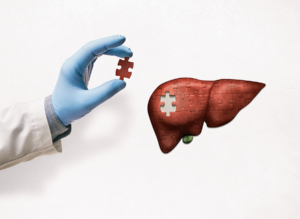
The liver is a large organ in the abdomen, the size of a football, that performs over 500 functions per day. It is defined both an essential organ,
necessary for life, and a gland, which produces hormones and proteins for the rest of the body. To highlight a few things the liver is responsible for:
- Cleaning the body from toxins, including many types of drugs
- Regulating the amount of blood in the body as well as processes red blood cells and the hemoglobin they carry
- Metabolizing protein, fats and carbohydrates
- Producing bile, which breaks down fat
- Manufacturing substances necessary for blood clotting
- Storing glycogen and vitamins that can be used later
- Producing protein for blood plasma – notably albumin
When chronic liver disease develops, it compromises these vital functions. This is even more concerning when liver disease exists concomitantly
with chronic kidney disease (CKD). People living with CKD already struggle with elevated waste products in their body, anemia, and inadequate levels
of body proteins.
That’s why it’s important for everyone, with or without CKD, to take steps to support liver health. The basics of supporting a health liver include:
- Limiting alcohol intake
- Eating lots of fruits and veggies, but be sure to wash them first
- Getting vaccinated against viral hepatitis
- Regularly washing your hands
- Exercising
- Taking medications only as prescribed
- Discussing use of herbal supplement with your doctor or dietitian, many can harm your liver
What does not NOT make the list is the recommendation to do liver cleanses or detoxes. Over the years, several products have been made available
on the market that claim to support your health by cleansing your liver whether it’s part of a routine practice or to be used after a weekend of heavy indulgences in food and alcohol. These products are not regulated by the FDA nor are they supported by research. In fact, some products contain harmful ingredients that may damage the liver.
If someone develops liver disease, there are still steps to be taken to support better quality of life and health outcomes. This includes:
- Getting enough calories and protein spaced regularly throughout the day and avoiding long periods of fasting to prevent muscle loss and malnutrition
- Alcohol cessation
- Maintaining a healthy weight or losing weight if obese
- Eating a variety of healthy foods including vegetables, fruits, and whole grains
- Avoiding excess salt intake
Further, patients with comorbid liver and kidney failure are at especially high risk of developing malnutrition and protein-energy wasting.
To ensure adequate calorie and protein intake, these patients should be counseled to eat protein and calorie dense foods and supplements.
If they continue to struggle to meet nutritional needs, dialysis patients also have access to intradialytic parenteral nutrition (IDPN) for hemodialysis (HD)
and intraperitoneal nutrition (IPN) for peritoneal dialysis (PD) which can provide additional calories and protein depending on dialysis modality
and nutrition needs.
To learn more about how IDPN and IPN can support malnourished patients on dialysis, visit our website and take the opportunity to view our recently published abstract on patients with cirrhosis receiving IDPN.
References
- European Association For The Study Of The Liver. (2019). EASL Clinical Practice Guidelines on nutrition in chronic liver disease. Journal of hepatology, 70(1), 172-193.
- Sharma, A., & Nagalli, S. (2021). Chronic liver disease. In StatPearls [Internet]. StatPearls Publishing.
- Kumar, R., Priyadarshi, R. N., & Anand, U. (2021). Chronic renal dysfunction in cirrhosis: A new frontier in hepatology. World journal of gastroenterology, 27(11), 990–1005. https://doi.org/10.3748/wjg.v27.i11.990
- 455 Intradialytic Parenteral Nutrition Positively Impacts Albumin in Hemodialysis Patients with Cirrhosis. (2024). American Journal of Kidney Diseases, 83(4), S140. https://doi.org/10.1053/j.ajkd.2024.01.458
We thank our guest blogger Maiya Slusser, MS, RDN, CD, CNSC, for sharing her knowledge and writing this blog post!

